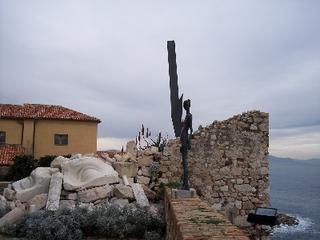Wednesday, September 28, 2005
Musée Picasso Antibes

As the title may render, you might think that this post is another unusual post: not a book reading personal impression. Unluckily enough, you are not hundred percents without error. It is about a book, a simple book. It is about a museum guide book, Picasso Museum in Antibes.
We visited the museum last December, just before we moved to our new appartement and the book was bought in the museum souvenir shop.
The book, just like any other simple guide book is dry. But the pictures are quite generous for a small and relatively cheap book. The Venezia Academia Museum guide book that we also have, for example, includes much more densed pictures. The main Picasso work owned by the museum, Joie de Vivre, is deservedly rewarded two pages of the book.
 The museum itself is awesome, it is a three levels medieval castel called Grimaldi Castel. Picasso lived and worked there in 1946 accompanied by his spouse François Gilot. The most important work fulfilled in the period is the Joie de Vivre, a picture that is representative to his mood at the time: the joy of life.
The museum itself is awesome, it is a three levels medieval castel called Grimaldi Castel. Picasso lived and worked there in 1946 accompanied by his spouse François Gilot. The most important work fulfilled in the period is the Joie de Vivre, a picture that is representative to his mood at the time: the joy of life.Other pictures are not less interesting. I love Femme dans un fauteuil and Pêcheur attablé pictures. Some ceramic plates handcrafted by Picasso as result of his visit to a poterie in Vallauris, also in the period, are also interesing and eye catching and worth to see.
The museum collection is not limited to Picasso's works. There are some works of Joan Miro, Fernand Leger, and Magnelli to name a few. A special mention for Nicolas de Stael with his breathtaking Le Grand Concert and Fort Carre d'Antibes, one of his last works before his suicide 1955 in Antibes.
From the guide, we will see clearly the context of the works that we see in the museum. It is a good souvenir for one who has visited the museum, or a good resource for one who wants to visit the museum. It is from the guide I know who Francois Gilot was, and what happened to Stael.


0 Comments:
Post a Comment
<< Home